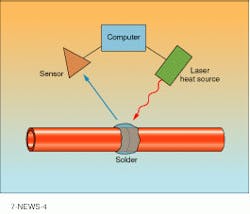Researchers from Lawrence Livermore National Laboratory (LLNL, Livermore, CA) and Convergent Energy Enterprises (Spring Valley, NY) will spend the next three years developing a tissue-welding feedback system that is expected to increase physician acceptance of this procedure. The primary focus of this research will be to create optical sensors that can be used by any surgical system to automatically determine weld endpoints and signal to the surgeon when a good weld is achieved. The $3.2 million project is the result of a Cooperative Research and Development Agreement (CRADA) recently awarded to LLNL and Convergent by the University of California.
Under the CRADA, researchers at LLNL will evaluate various tissue types and properties and correlate them with "good welds"; they will also identify the most appropriate sensing technology and build a prototype of the sensor. While previous signatures have been optically based, the LLNL team will also look at using an IR-sensitive diode or detector, according to David Matthews, director of the LLNL team. Outside of the tissue-welding applications, LLNL also hopes to use the same optical diagnostics to establish the optical signatures of particular tissues and assign color coding to them; according to Matthews, this would greatly enhance a surgeon`s ability to identify various tissues during minimally invasive surgery.
Convergent will provide engineering support to LLNL during the prototyping phase and will also be responsible for developing a commercial version of the prototype, overseeing the clinical trials, and establishing strategic manufacturing and distribution relationships. According to Barbara Soltz, CEO of Convergent, the primary goal is to develop a compact, low-cost feedback device that will work interchangeably with diverse surgical technologies and is user friendly. "The sensor is the focus of this project, but equally important is the breadth of its application," Soltz says. "Because it is being designed to work with any type of surgical system, we have the potential for much larger market share and greater commercial viability."
It also means additional system design challenges. "Because we want this product to interface with a laser as well as an electrosurgery device, other parameters have to be considered," Soltz says. In this case, the solution is likely to be a modular design that will allow less-expensive interface components to be easily switched from model to model while more-expensive components remain the same. Eventually, she says, "a surgeon who uses a variety of surgical techniques might need only one of these systems, swapping interfaces as needed when moving from technique to technique."
Overcoming obstacles
The ability to weld two pieces of tissue together using various energy sources has been the subject of numerous clinical investigations; among other things, these studies have shown that welding an incision is faster than suturing and reduces the inflammatory response of tissue to foreign bodies. Despite these clear advantages, however, tissue welding has yet to achieve much clinical success.
Several technical and clinical limitations have contributed to this lack of physician enthusiasm. Unlike sutures and staples, which are fine for most general-surgery applications, tissue welding is dependent on the availability of generally cumbersome equipment. In addition, because tissue welding involves freehand delivery and eyeball judgment of weld completion, the procedure can be frustrating and unreliable in inexperienced hands. Thus, a device that simplifies the process and ensures consistent, reproducible results could be the first major step in moving tissue welding out of the laboratory and into the operating room.
"With a device that allows the surgeon to obtain a `perfect` weld every time, we should expect to see a higher degree of tissue-welding acceptance," says Michael Treat, M.D., director of laparoendoscopic surgery at Columbia-Presbyterian Medical Center (New York, NY) and a leading tissue-welding researcher.
"The whole idea behind this project is to develop a device that can take over and become the `expert` so that potential users who are not experienced in tissue welding will not have to spend years on training," adds Barbara Soltz. Other anticipated end-user benefits include greater surgical precision, accelerated healing response, and reduced length of medical care.
To ensure that the system meets the needs of both novice and expert users, Treat and Lawrence Bass, M.D. (College of Physicians & Surgeons, Columbia University, New York) are working closely with LLNL and Convergent throughout its design phase; they are also slated to participate in the clinical trials, which Soltz says should begin sometime in 1998.
"Dr. Bass and I want to make sure that this device is clinically relevant and corresponds to what we need," says Treat. "There are some very subtle technical aspects associated with tissue welding that a surgeon can pick up, but it takes time. If this device can overcome some of these issues—namely, reliability and reproducibility—it could be a real breakthrough."
About the Author
Kathy Kincade
Contributing Editor
Kathy Kincade is the founding editor of BioOptics World and a veteran reporter on optical technologies for biomedicine. She also served as the editor-in-chief of DrBicuspid.com, a web portal for dental professionals.
